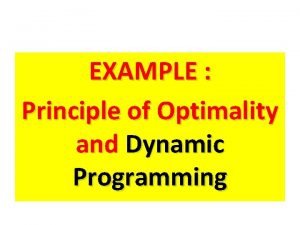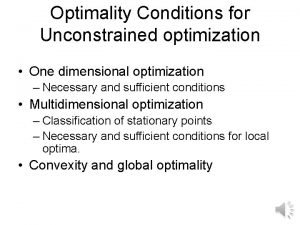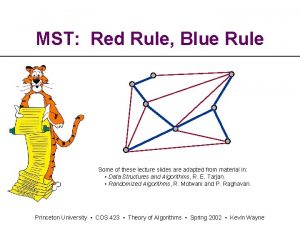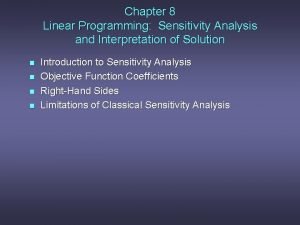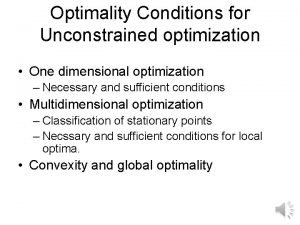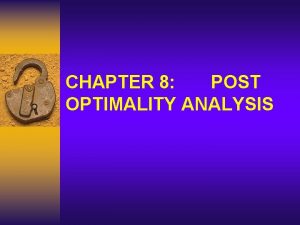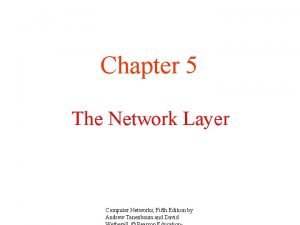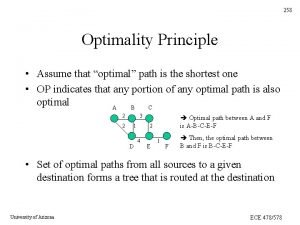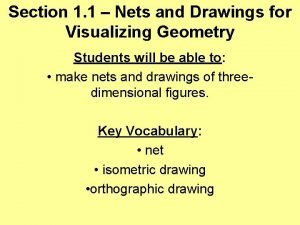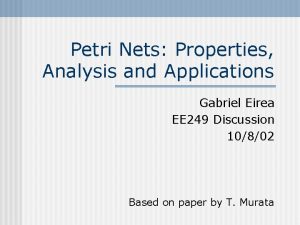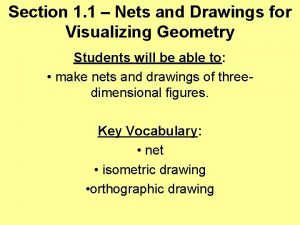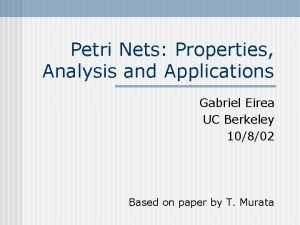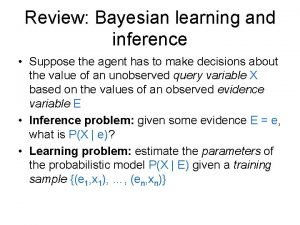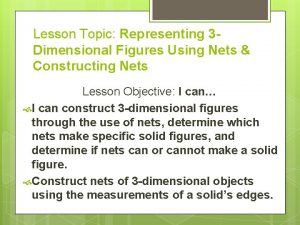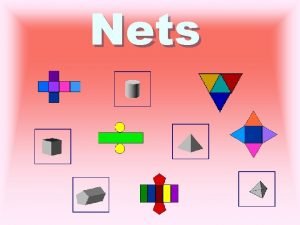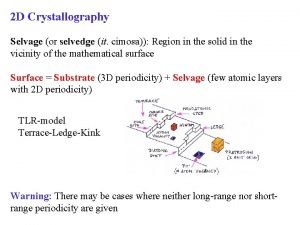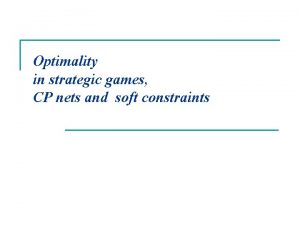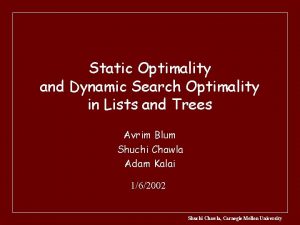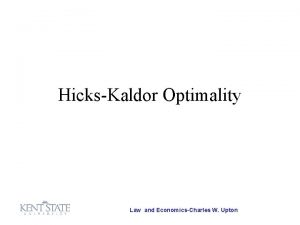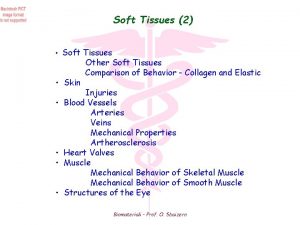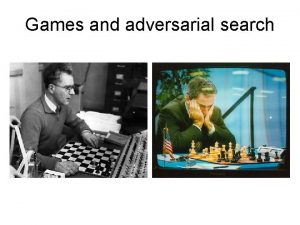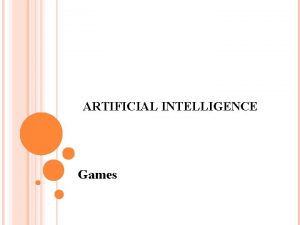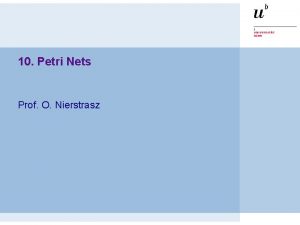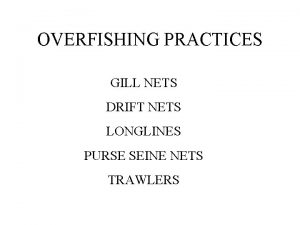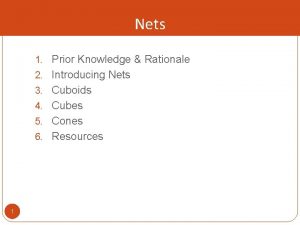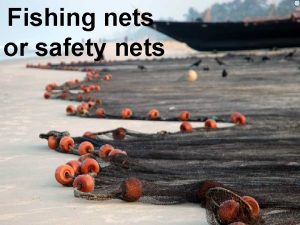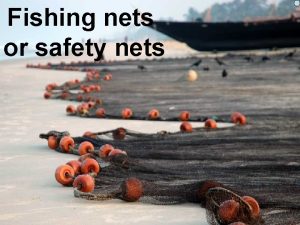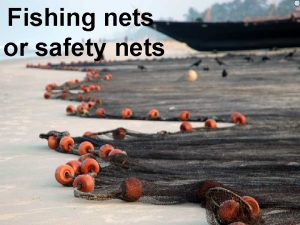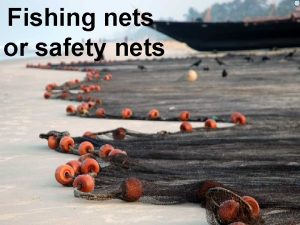Optimality in strategic games CP nets and soft



































- Slides: 35

Optimality in strategic games, CP nets and soft constraints

Main aim n n n To compare the notion of optimality used in many formalisms To throw the basis for exploiting results in one field and reuse them in the other field Strategic games q Agent interaction while pursuing their own interest (payoff function) CP nets q Agent’s qualitative and conditional preferences Soft constraints q Agent’s quantitative preferences

Outline 1. 2. 3. Strategic games Relation between CP nets and games Relation between soft constraints and games

Parametrized Strategic games n n A set of players 1, . . , n For each player i: q q n A set of strategies Si A strict total order >i over Si depending on s-i (a joint strategy of all players but player i): payoff function Example (prisoner’s dilemma): 2 players, 2 strategies (ci, ni) for each player i C 2 N 2 C 1 3, 3 0, 4 N 1 4, 0 1, 1

Pure Nash equilibria n n N 2 0, 4 N 1 4, 0 1, 1 A strategy si is a best response for i to s-i if si ≥i s’i for all s’i in Si A joint strategy s is a pure Nash equilibrium if each si is a best response to s-i q q q n C 1 C 2 3, 3 Also: for all i, for all s’i in Si, si ≥i s’i No player has regrets on the strategy he chose But there could be better joint strategies if more than one player changed its strategy In the example, one Nash equilibria (NE): (N 1, N 2)

Pareto efficient joint strategies n n No other joint strategy is better or equal for all agents, and better for at least one Example: q q (N 1, N 2): unique Nash equilibrium All other joint strategies are Pareto efficient (PE) C 2 N 2 C 1 3, 3 0, 4 N 1 4, 0 1, 1

Dominance between strategies n n A strategy si is never a best response for i if it is not a best response to any joint strategy s-i In the example: for each player i, Ci is never a best response C 2 N 2 C 1 3, 3 0, 4 N 1 4, 0 1, 1

Elimination of dominated strategies n G NBR G’ q q G’ subgame of G For all i, each si in Si-S’i is never a best response for i in G Eliminate from the strategies of each players those that are never a best response

Nash equilibria and strategy elimination n n If G NBR G’, then s Nash equilibrium of G iff Nash equilibrium of G’ In the example: Ci is nbr, thus G’ has one row and one column, which is the unique Nash equilibrium 1, 1 C 2 N 2 C 1 3, 3 0, 4 N 1 4, 0 1, 1

From CP-nets to games n Given a CP-net N, we build the game g(N) q q q Players: features Strategies of player i: domain of feature xi Payoff function of player i: CP table for xi n n Given s-i, s’i >i si iff s-i|par(xi) : s’i >i si in the cp table for variable i Thm: opt(N) = NE(g(N))

Example – CP net Fish, white, peaches fish>meat Main course fish meat Main course Fish, red, peaches Fish, white, berries Wine white > red Fish, red, berries Wine meat, red, peaches red > white peaches > strawberries Fruit meat, white, peaches meat, red, berries meat, white, berries

CP net Param. Strategic Game fish>meat Main course fish meat Main course Wine white > red Wine red > white peaches > strawberries Fruit Three players: 1 = main course, 2 = wine, 3 = fruit Two strategies for each player: S 1= {meat, fish} S 2={red, white} S 3={peaches, strawberries} Payoff functions For 1 main course: fish > meat, always For 2 wine: fish, -- white > red meat, -- red > white For 3 fruit: peaches > strawberries, always

Example: optimals and Nash equilibria n Unique optimal for CP-net: (fish, white, peaches) q n Hard constraints: fish, peaches, fish white, meat red For the game: q q Meat is nbr for main course Strawberries is nbr for fruit Once meat is eliminated, red is nbr for wine Nash equilibrium: fish, white, peaches

From games to CP-nets n Given a game G, we build a CP-net n(G): q q n Feature xi: player i Domain of xi: strategies for player i Parents of xi: all the other features CP table of xi: s-i: si > s’i if si >i s’i given s-i Thm. : NE(G) = opt(n(G))

Example C 1 N 1 n n C 2 N 2 3, 3 0, 4 4, 0 1, 1 Hard constraints: q x 2=c 2 → x 1=n 1 q x 2=n 2 → x 1=n 1 q x 1=c 1 → x 2=n 2 q x 1=n 1 → x 2=n 2 Unique solution: x 1=n 1, x 2=n 2 n n Two features: x 1, x 2 D(x 1)={c 1, n 1} D(x 2)={c 2, n 2} x 1 depends on x 2 q q n x 2=c 2: n 1 > c 1 x 2=n 2: n 1 > c 1 x 2 depends on x 1 q q X 1=c 1: n 2 > c 2 X 1=n 1: n 2 > c 2

Reduced CP-nets n n If y is a parent of x, but the preference over the domain of x does not depend on y, then we can remove y from the parents of x eliminate rows From a CP net N to its reduced version r(N)

Example: reduced CP-net n n Two features: x 1, x 2 D(x 1)={c 1, n 1} D(x 2)={c 2, n 2} x 1 depends on x 2 q q n x 2=c 2: n 1 > c 1 x 2=n 2: n 1 > c 1 x 2 depends on x 1 q q X 1=c 1: n 2 > c 2 X 1=n 1: n 2 > c 2 n n n Two features: x 1, x 2 D(x 1)={c 1, n 1} D(x 2)={c 2, n 2} x 1 and x 2 independent For x 1: n 1 > c 1 For x 2: n 2 > c 2

CP-net techniques in games n n From game G to n(G) From n(G) to r(n(G)) Hard constraints for r(n(G)) Optimals of r(n(G)) = Nash equilibria of G G n n(G) r Nash equilibria of G = optimals of r(n(G))

Example C 1 N 1 C 2 N 2 3, 3 0, 4 4, 0 1, 1 n n Two features: x 1, x 2 D(x 1)={c 1, n 1} D(x 2)={c 2, n 2} x 1 depends on x 2 q q n x 2=c 2: n 1 > c 1 x 2=n 2: n 1 > c 1 x 2 depends on x 1 q q X 1=c 1: n 2 > c 2 X 1=n 1: n 2 > c 2

Example: reduced CP-net n n Two features: x 1, x 2 D(x 1)={c 1, n 1} D(x 2)={c 2, n 2} x 1 depends on x 2 q q n x 2=c 2: n 1 > c 1 x 2=n 2: n 1 > c 1 x 2 depends on x 1 q q X 1=c 1: n 2 > c 2 X 1=n 1: n 2 > c 2 n n n Two features: x 1, x 2 D(x 1)={c 1, n 1} D(x 2)={c 2, n 2} x 1 and x 2 independent For x 1: n 1 > c 1 For x 2: n 2 > c 2

Example: reduced CP-net n n n Two features: x 1, x 2 D(x 1)={c 1, n 1} D(x 2)={c 2, n 2} x 1 and x 2 independent For x 1: n 1 > c 1 For x 2: n 2 > c 2 n Hard constraints: q q n x 1=n 1 x 2=n 2 Thus x 1=n 1, x 2=n 2 unique optimal solution of the CP-net and Nash equilibrium of the game

Games and acyclic CP-nets n n From game G to r(n(G)) If r(n(G)) is acyclic, then G has one Nash equilibrium, and linear time to find it n G n(G) r Nash equilibrium of G = optimal of r(n(G)) acyclic linear time

Optimality in SCSPs, NE in Games n n From Games to CSPs Full power of SCSPs no needed to model NE Game G CP-net n(G) Greco et al. 2005 CSP C(G) Optimality Constraints of N(G) Equivalent

Optimality in SCSPs, NE in Games n n From a SCSP P to a game L(P) Local Approach q q q Players: one for each variable Strategies for a player i: all values in domain of xi Payoff of player i for joint strategy s: preference for assignment s in constraints involving xi

local Example 1: Fuzzy SCSP game X Y n n n Three players x, y, z Two strategies a, b Payoff functions q q For x: px(aa-)=0. 4, px(ba-)=0. 3… For y: n n n (a, a) 0. 4 (a, b) 0. 1 (b, a) 0. 3 (b, b) 0. 5 p(aaa) = min(0. 4, 0. 4) = 0. 4 p(aba) = min(0. 1, 0. 1)=0. 1. . . Two Nash equilibria: aaa and bbb Optimal solutions: only bbb (a, a) 0. 4 (a, b) 0. 3 (b, a) 0. 1 (b, b) 0. 5 Z

local Example 2: Fuzzy SCSP game X Y n n n Three players x, y, z Two strategies a, b Payoff functions q q n n n (a, a) 0. 1 (a, b) 0. 2 (b, a) 0. 1 (b, b) 0. 2 For x: px(aa-)=0. 9, px(ba-)=0. 6… For y: n n (a, a) 0. 9 (a, b) 0. 6 (b, a) 0. 6 (b, b) 0. 9 p(aaa) = min(0. 9, 0. 1) = 0. 1 p(aab) = min(0. 6, 0. 2)=0. 2. . . Two Nash equilibria: aab and bbb Optimal solutions: only aab, abb, bab, bbb Z

Strictly monotonic combination n In general, no relationship between optimal solutions of P and Nash equilibria of L(P) However, some relationship exist if combination is strictly monotonic Thm. : Soft CSP P with strictly monotonic combination Opt(P) NE(L(P))

Classical CSPs games n n n Classical constraints are combined via logical and (which is not strictly monotonic) However, if we consider consistent CSPs, the result holds Thm. : consistent CSP Sol(P) NE(L(P))

Optimality in SCSPs, NE in Games n n Given an SCSP P, build a game GL(P): Global mapping q q q n n n Players = variables Strategies = domain values Payoff for player x for strategy s: preference value for that assignment (by looking at all constraints) Note: same payoff for all players Theorem: Opt(P) NE(GL(P)) Subset relation for all classes of SCSPs

Optimality in SCSPs, PE in Games n From a game G to an SCSP L’(G): q q Variables = players (n) Domains = strategies Semiring = Cartesian product of n semirings For each variable xi, one constraint involving xi and its neighborhood n n n pref(t) = (d 1, . . . , dn), where dj = 1 j for j i, and di = F(pi(t)) F is bijection from the payoffs to preferences in a csemiring Thm. : Game G opt(L’(G)) = PE(G)

Example C 1 N 1 C 2 N 2 3, 3 0, 4 4, 0 Semiring: weighted x weighted (c 1, c 2) (7, 0) (c 1, n 2) (10, 0) (n 1, c 2) (6, 0) (n 1, n 2) (9, 0) X 1 (c 1, c 2) (0, 7) (c 1, n 2) (0, 6) (n 1, c 2) (0, 10) (n 1, n 2) (0, 9) 1, 1 n n Pareto efficient joint strategies: all but (1, 1) x 2 Optimal solutions: q q q (c, c) with pref. (7, 7) (n, c) with pref. (10, 6) (c, n) with pref. (6, 10)

Optimality in SCSPs, PE in Games n From SCSPs to Games n If we use the local mapping q n Opt(P) ⊆ PE(L(P)) If we use global mapping q Opt(P) = PE(L(P))

Summary : CP-nets and NE games 1 -1 N’ not reduced r N reduced r n(g(N)) g g g(N) n

Summary: SCSPs and Games n Nash Equilibria n Pareto Efficient = = CSP Game ⊆ SCSP t. m s x . Game SCSP glo ⊆ Game ⊆ l a loc bal SCSP Game al loc glo bal = Game

References n n n CP-nets and Soft Constraints Carmel Domshlak, Steven David Prestwich, Francesca Rossi, Kristen Brent Venable, Toby Walsh: Hard and soft constraints for reasoning about qualitative conditional preferences. J. Heuristics 12(4 -5): 263 -285 (2006) C. Boutilier, R. I. Brafman, Carmel Domshlak, H. H. Hoos, and D. Poole. Preference-based constraint optimization with CP-nets. Computational Intelligence, 20(2): 137– 157, 2004 Games, CP-nets and Soft Constraints Georg Gottlob, Gianluigi Greco, Francesco Scarcello: Pure Nash Equilibria: Hard and Easy Games. J. Artif. Intell. Res. (JAIR) 24: 357 -406 (2005) Krzysztof R. Apt, Francesca Rossi, K. Brent Venable, Comparing the notions of optimality in CP-nets, strategic games, and soft constraints, to appear in Annals of Mathematics and Artificial Intelligence.
 Types of games outdoor
Types of games outdoor What is optimality principle in computer networks
What is optimality principle in computer networks What is optimality principle in computer networks
What is optimality principle in computer networks Principle of optimality with example
Principle of optimality with example Subnet
Subnet A* optimality proof
A* optimality proof Optimality conditions for unconstrained optimization
Optimality conditions for unconstrained optimization Rule
Rule What is shadow price in sensitivity analysis
What is shadow price in sensitivity analysis One dimensional unconstrained optimization
One dimensional unconstrained optimization Post optimality analysis
Post optimality analysis The optimality principle in computer networks
The optimality principle in computer networks Optimality principle of routing
Optimality principle of routing 1-1 practice nets and drawings for visualizing geometry
1-1 practice nets and drawings for visualizing geometry Petri nets properties analysis and applications
Petri nets properties analysis and applications 1-1 nets and drawings for visualizing geometry answers
1-1 nets and drawings for visualizing geometry answers Semantic nets and frames
Semantic nets and frames Nets and drawings for visualizing geometry
Nets and drawings for visualizing geometry Cylinder net
Cylinder net Petri nets properties analysis and applications
Petri nets properties analysis and applications What is the status of peeta’s leg wound
What is the status of peeta’s leg wound Strategic complements definition
Strategic complements definition Strategic competitiveness
Strategic competitiveness Tows matrix
Tows matrix Bayes nets
Bayes nets Represent solid figures using nets
Represent solid figures using nets Semantic network in ai
Semantic network in ai Surface area using nets
Surface area using nets Net triangular prism
Net triangular prism Nets church planting
Nets church planting List the 4 nets for better internet searching.
List the 4 nets for better internet searching. Doc 4444
Doc 4444 Nets blox
Nets blox Safety nets must be drop tested
Safety nets must be drop tested Bravais nets
Bravais nets Semantic nets
Semantic nets



